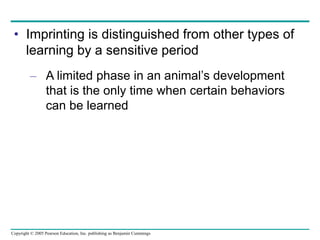This document discusses behavioral ecology and how behaviors evolve through natural selection. It covers topics like how humans have studied animal behavior, the distinction between proximate and ultimate causes of behavior, examples of innate behaviors and how they are genetically influenced (e.g. fixed action patterns, imprinting, directed movements), communication methods like chemical signals, and how environment can interact with genetics to influence learned behaviors. Learning and problem solving are also examined from the perspectives of behavioral ecology.








































































































